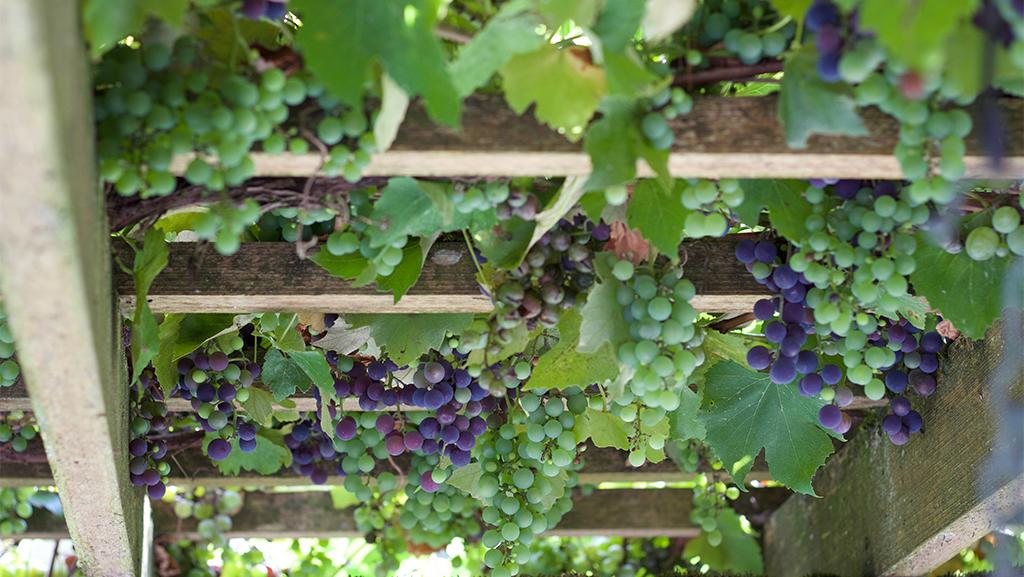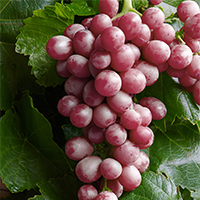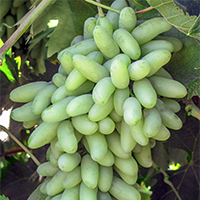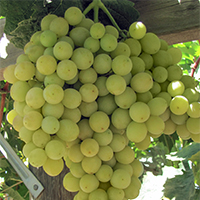Have you ever daydreamed of picking huge clusters of sun-warmed, juicy grapes from your backyard vines? Growing grapes is easier than you think. Here’s how to grow grapes confidently.
Grapes can be grown in USDA zones 4-10, which is to say almost anywhere in the continental United States. If you have good soil, some space to spare, and don't mind some annual pruning, growing grapes is easy. It's definitely not more difficult than any other backyard crop.
The keys to success are first deciding what sort of crop you want to grow (to eat or make wine) and then choosing the right varieties that will grow and produce well in your area. We've listed some of our favorite varieties below. Once you have this locked down, follow the steps below for planting, tending, and harvesting. You can expect to harvest delicious fruits in the third or fourth year, around late summer or early fall.
How to Grow Grapes in 5 Easy Steps
1. Find the best place to plant your grapes
Basically, you need a large, open, sunny space with good soil. Grapes need about 50 to 100 square feet per vine if growing vertically on a trellis or arbor. They need about 8 feet between rows if planting horizontally in rows. Plus, seven to eight hours of direct sun each day. While they'll grow in a range of soils, they'll thrive in well-drained, rich, organic soil (grapes cannot tolerate wet feet). Soil that has been mixed deep down with ample compost or soil conditioner is ideal. Air circulation on all sides helps ward against fungal diseases such as powdery mildew.
2. Choose the best grape variety for your climate
There are three basic types of grapes: American, European, and Muscadine. There are also hybrids (like our favorite Zestful grapes) made by combining American and European varieties.
American (Vitis labrusca) grapes are the most cold-hardy (zones 4-7) and thrive in short-season growing areas such as the Northeast. These are most often used for table grapes, juices, and jellies.
European (Vitis vinifera) grapes prefer a warm and dry Mediterranean-type climate (zones 7-10) with a longer growing season. Depending on the variety, these are used for winemaking and as table grapes.
Muscadine (Vitis rotundifolia) grapes are native to North America and grow well in the humid South (zones 7-9). They are most often used for winemaking and as table grapes.
Choose carefully according to your USDA zone. Some varieties like cooler temperatures, while others thrive in the heat. Consult your local Independent Garden Center for the best varieties for your particular area and needs
Here are a few of our favorite varieties of Hybrid, American, and European table grapes.
Zestful™: Our Favorite Table Grapes on the Market
Zestful™
Lollipop Grape
Perfect for backyard growing, with fast-growing vines and large clusters of tasty, deep-red, seedless grapes. Delicious fresh and dried into raisins. Zones 7-9.
Photo: Monrovia by Brandon Friend-Solis
Zestful™
Waterfall Grape
Unique finger-like green grapes hang in long, loose clusters on this fast-growing vine. Abundant fruit ripens in late summer. Zones 7-9.
Photo: Monrovia
Zestful™ Golden
Chalice Grape
Fast-growing vines set very large clusters of crisp, delicious champagne-colored fruits in summer that are nearly completely seedless. Zones 7-9.
Photo: Monrovia
Best American (Cold-Hardy) Table Grapes
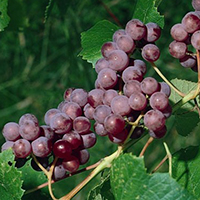
Catawba Grape
A vigorous, hardy, deciduous vine with bold-textured, deep green foliage. Medium-sized clusters of round purple-red grapes are well suited for jellies, juices, and sweet wines. Zones 4-8.
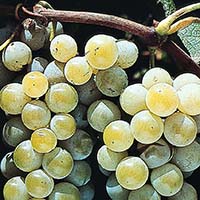
Niagara Grape
A vigorous cold-hardy, and deciduous vine that produces large, full clusters of green-gold grapes that are sweet and juicy. Zones 4-8.
Photo: Monrovia
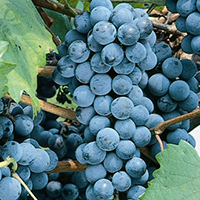
Eastern Concord Grape
Grown for its clusters of tasty, aromatic blue-black grapes that harvest from late August to September. Zones 4-8.
Photo: Hort Printers
Best European Table Grapes
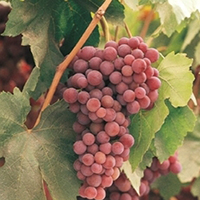
Flame
Seedless Grape
A favorite early-season variety that's prized for its excellent flavor. Medium-sized clusters of round, red, seedless fruit with a firm, crisp texture. Zones 7-9.
Photo: Hort Printers
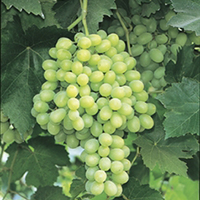
Thompson
Seedless Grape
A vigorous variety with large bunches of small, sweet, mild-flavored green grapes. A fantastic mid-season table grape. Zones 7-9.
Photo: Hort Printers
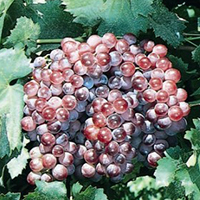
Ruby
Seedless Grape
A sweet dessert variety with large clusters of small to medium seedless, red to reddish-black berries that ripen mid-season. Zones 7-9.
Photo: Hort Printers
3. Properly plant your new grapevine
Table grapes don't need a fancy support system. Although it's good to get them off the ground and onto a trellis where you can easily prune and harvest. Wine grapes will require a horizontal structure that gives them the support they need and allows you to train them. In mild winter areas (USDA Zone 7 and warmer) you can plant your grapevines in early winter. In colder regions, wait for early spring. Grapevines set deep roots (as much as 15 feet). Therefore, dig a planting hole about two feet deep and wide and enrich it with compost.
How Many Grape Vines Should I Plant?
- Mature table grapes can produce 15 to 30 pounds per vine. You may only want to plant a couple of vines.
- Mature wine grapes produce about 12 pounds per vine, and it takes 40 pounds to make 12 bottles. If you’re serious about making wine, you’re going to need a lot of vines.
4. Maintain and prune your grapevines
Grapes produce fruit on growth that is a year old. This makes it important to keep a pruning schedule to remove older growth and ensure new growth develops. The most common mistake made with grape pruning is not pruning hard enough. Once a grapevine is fully established, you will actually be cutting off more plants than you leave behind.
Grapes can be trained in several different ways. This depends on your garden goals and the support structure you plan to use.
- Vineyard style: The classic system of two wires strung between posts. This has the benefit of keeping your grapes where they are easy to harvest. It only requires a narrow space, such as along a fence or wall. This method has one central trunk and a one-year-old cane with about 8 buds going out horizontally on each wire. If you want to see how the professionals prune their grapevines, you can find more information here.
- Onto a trellis or pergola: A great way to incorporate edible plants in a decorative manner. Grapes can be trained onto arches or used to provide seasonal shade on a pergola. How lovely would it be to reach up and grab a snack while relaxing on your patio?! You can find detailed instructions on training and pruning grapes on a pergola here.
Looking for a simpler, more casual method? Here's how to keep your grapes under control and produce fruit without becoming a pruning expert. Prune your grapes in late winter or early spring. Only two things should be left when you are done pruning your grapevine; a permanent main trunk or trunks and growth that is a year old. You won’t want to keep all the year-old growth- there might be a lot! Get rid of unneeded older wood, and thin out and shorten the year-old wood. You can leave anywhere from 2 to 8 buds on a cane.
Pruning can be done in summer to tidy up the vines. Especially if you find they are getting a little wilder than you like. Thinning can also help the fruit get more sun and increase airflow to prevent powdery mildew. If you find the fruit is growing in dense shade, you might want to do some thinning.
More information on pruning can be found here.
Common grape maintenance challenges
Powdery mildew is the most common disease affecting grapes. It can be controlled by improving air circulation and avoiding overhead watering. Continuous, severe cases may require spraying. Birds? Try covering with netting.
5. Occasionally feed your grapes
Grapevines generally don’t require much fertilizer, so fertilize sparingly. In early spring, apply about eight to ten ounces of 10-10-10 or 10-20-20 fertilizer. Add a layer of high-quality compost to the base of your grapes in early spring. This can often provide the right amount of nutrients to the soil for your grapes to grow and produce annually.
Nurturing Your Grapevines: Combating Pests and Diseases
It is very important to manage potential pest and disease issues effectively to ensure a bountiful harvest of delicious grapes from your backyard vines and successfully produce grapes. Start by selecting a sunny location with good air circulation to reduce the likelihood of problems.
Regularly inspect your vines for signs of insect damage and remove any pests promptly. Keep an eye out for:
- Japanese beetles that chew holes in the leaves
- Spotted wing drosophila
- Yellow jackets and multicolored Asian lady beetles that can damage ripening grapes
Use netting to protect your ripening grapes from hungry birds. To prevent fungal diseases like downy mildew, follow these steps:
- Prune your vines annually to maintain proper air circulation
- Remove and discard any diseased portions of the vine promptly to stop the spread of infection
- Clean up fallen leaves and fruit in the fall to reduce the risk of disease in the following spring
Be mindful of common fruit rots, such as Botrytis bunch rot, black rot, phomopsis, anthracnose, and sour rot. To minimize the risk:
- Properly prune and manage grape clusters
- Remove dead blossom parts where Botrytis can grow
Lastly, avoid using herbicides like 2,4-D and dicamba near your grapevines, as they are highly sensitive to these chemicals. Consider asking your neighbors to do the same to prevent unintentional damage.
By staying proactive and attentive in your grapevine management, you'll be well on your way to enjoying a fantastic harvest of homegrown grapes.
Learn More About Growing Edibles Confidently
- Find large, healthy, and thriving Monrovia plants at your local Monrovia retailer.
- Sign up for the Grow Beautifully newsletter. You'll get first access to exclusive plants, new editions, live webinars, free digital guides, expert design advice, and gardening tips.
- How to Grow Fig Trees
- Grow a Grill Garden
- Elevated Edible Landscape Design
- How to Grow Berries in Containers
- Ultimate Guide to Growing Berries
- How to Grow Blueberries in Pots
- How to Use Berries to Make a Beautiful Garden
- Keep Strawberries Fruiting in Late Summer
- Putting Container-Planted Berries to Bed




